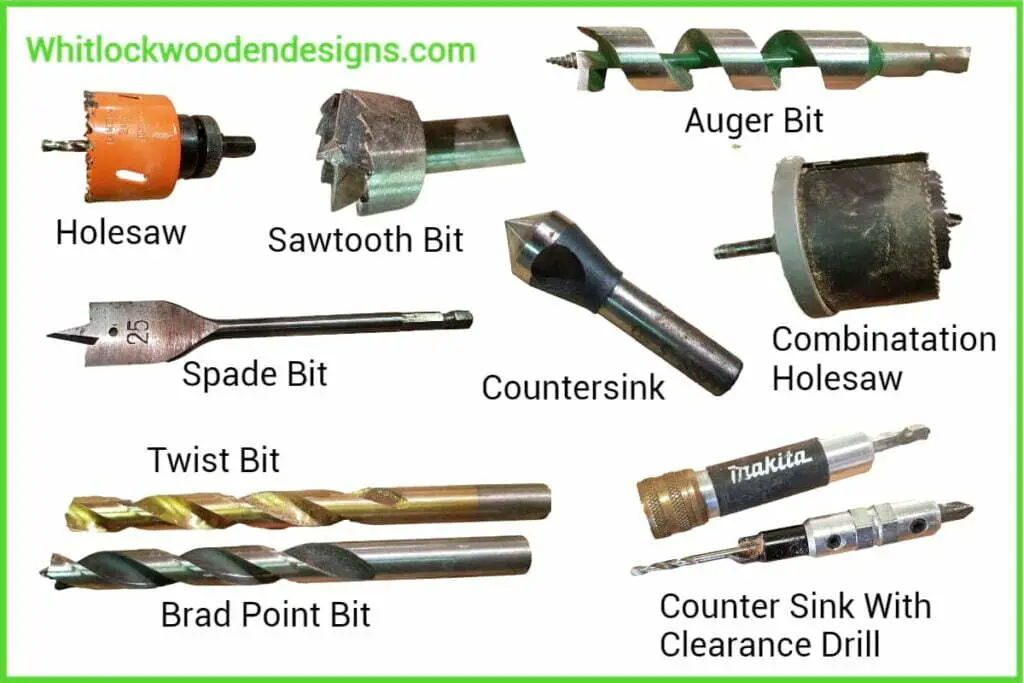Every woodworker needs a set of the best wood bits for the shop. If your a novice to woodwork or DIY, how do you know what is appropriate for the task? Getting the correct one for the task is essential, so make sure you pick it wisely.
Wood drills are used to bore holes in wood, but many sorts are available today. Here are some of them with their pros and cons listed below:
Different Types of Drill Bits for Wood
A variety of wood drill bit types and names are available in various shapes and sizes that we use to drill into wood. The most common drill is twist, spade, Forstner, or hole saws. Each bit serves a distinct function and is designed for a specific purpose. Selecting the proper bit is essential to get the highest results.
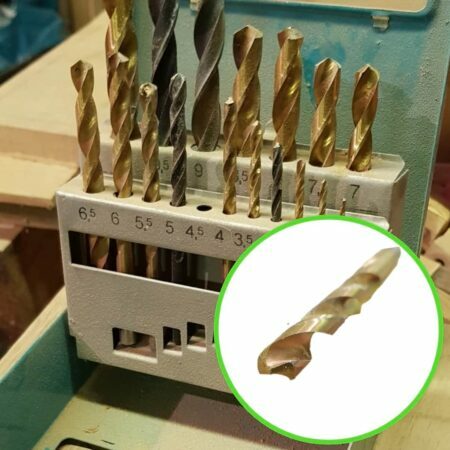
1. Twist Bit
There are several varieties on the market, but twist drill bits are the most prevalent. They come in various diameters and brands to fit your needs. The most common type of bit is HSS (high-speed steel). Consider the material and the hole size you want to make up to 16mm.
They are good for use with woods, some metals, plastics, and other substances. A wide range of sets for household or workshop use in popular 1 – 13 mm or the imperial equivalent.
Pros
Available in various sizes.
Acquiring is a breeze.
Simple to sharpen by machine.
Cons
Not ideal for use with all things.
Quality can vary.
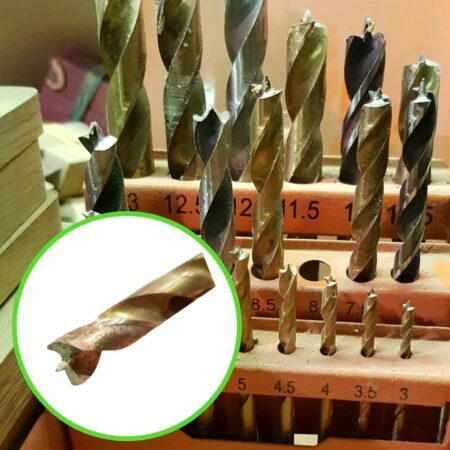
2. Brad-Point Bit
A Brad point bit has a sharp point to position the workpiece with two spurs for cutting. This allows for greater accuracy and stability when drilling.
Woodworkers know that a brad point drill bit is best for hardwood and softwood. The cutting action is clean and sharp, preventing splintering on the exit hole. A (lip and spur) bradpoint centres itself, so you don’t have to worry about drifting.
With a clean cutting action for precise dowel holes in wooden workpieces between 3 – 13mm.
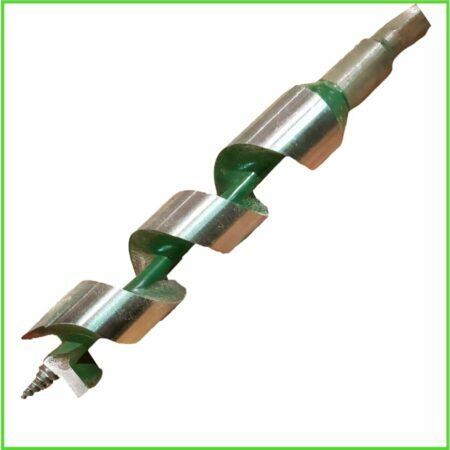
3. Auger Bit
The auger drill bit has a threaded tip that can cut a large deep hole. Augers produce cleaner holes than regular woodworking drill bits. They also offer a more energy-efficient solution.
The auger bit is ideal for drilling through tougher materials. It is 18 inches long, so it can go deep into timber. They feel more rigid and robust, making them an excellent option for tougher projects. It is possible to use with an electric drill, though it will pull through at an alarming rate and no control, better off in a hand brace.
Ship auger bits are a particular type of tool included in this category. Suitable for unusually thick applications, they will cut through nails without tool damage.
4. Installer Bit
Installer drill bits are a specialised tool to install difficult wiring. Electricians use these long, skinny “bell hanger” bits for pulling wires or similar installation work.
Besides their long length, they have a hole near the tip for use with pulling wire. This allows you to easily place electrical wires in tight spaces.
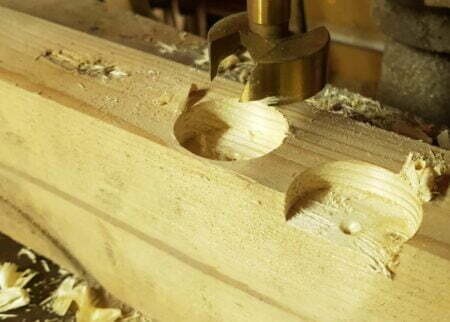
5. Forstner Bit
Forstner drill bits can drill larger diameter holes in timber than other tooling can. Most commonly found in drill presses and lathes but can also be utilised with hand-held tools.
Invented for gunsmiths, they create flat-bottomed holes apart from a small indentation. Versatile for a variety of purposes, they can cut overlapping holes.
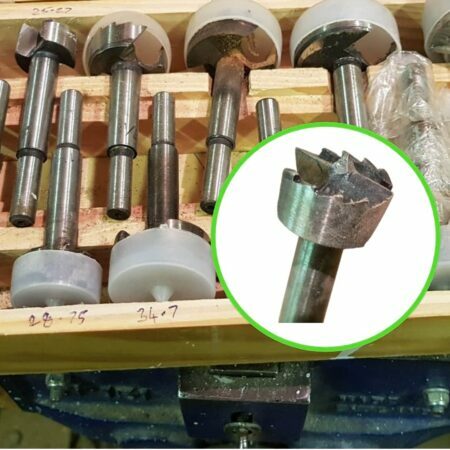
When boring into end grain, sawtooth bits are the preferred choice. The teeth cut into the end grain, preventing the bit from skating across the surface.
6. Self-Feed Bit
A self-feed drill bit, similar to the sawtooth, has a threaded end that pulls the bit through the wood swiftly. Since it doesn’t have any flutes, you’ll need to pull it back periodically to clear the dust and chips.
Self-feed bits are so named because they feed themselves into the material as you drill. This makes them quick to use, as you don’t have to worry about keeping the bit steady. As self-feeding “forces” cordless drills to maintain speed, torque may be a challenge.
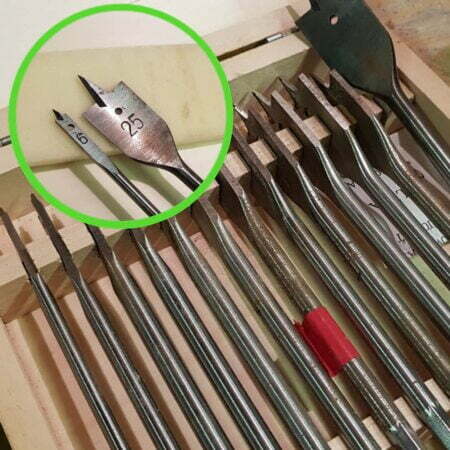
7. Spade Bit
Paddle or spade bits have a sharp pointed flathead, removing large amounts of chips. Diameters range in size from 6mm to 36mm, or ¼ inches to 1½ inches. They are commonly employed in construction projects for rough boring wood.
On the downside, they tend to cause splintering when they emerge from the workpiece. Finishing the piece from the other side helps woodworkers prevent splinters. They are perfect for drilling through wood quickly and easily at high speeds.
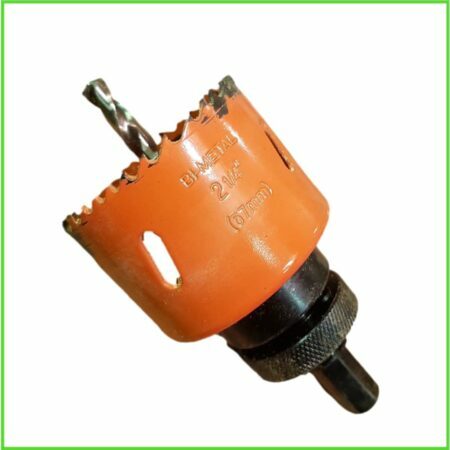
8. Hole Saw
A hole saw is a circular saw blade with teeth on its edge, enabling it to cut out circles. An arbour or mandrel with a shank is needed to attach the cylinder. Some come with a built-in shank, which eliminates the need for a pilot bit.
Hole saws are a regular sight in the construction industry. They are suited for a number of things, such as drilling bigger holes or creating circular cuts.
It’s vital to select the correct sort of hole saw for the material when you’re working with wood. For example, if you plan to cut metal, ensure it is bi-metal for ceramic tiles to get a carbide edge.
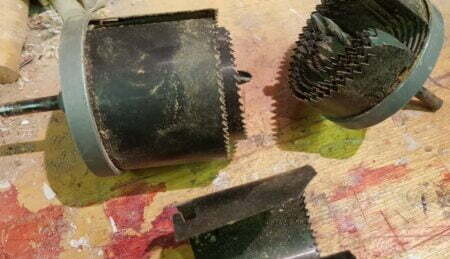
9. Combination hole saw
The combination holesaw is similar to the above but has multiple blades fixed in the head by radial screws. The blades are usually 25 to 62mm in width, suitable for wood, plastic, or metal. Cost-effective for homeowners or low usage, allowing users to cut various size holes.
The pilot function simplifies tool positioning. The cylinder slot allows the removal of any residue. You can employ a fine triangle file and setter to sharpen it.
10. Plug Cutter
Plug cutters are a great way of cutting timber plugs. This is a process of cutting plugs out of scrap timber offcuts from the current project piece. The pellets are designed to fit into concealed screw holes in a varnished project to disguise them. In most cases, this is done to preserve the wood’s colour and grain.
Craftsmen commonly use plug cutters for trim finishing. They are regularly seen as 3/8, 1/2, and 5/8. Plug cutters should only be installed in a drill press; they have no central lead to keep them aligned. Your pellet will be straight and professional looking as a result.
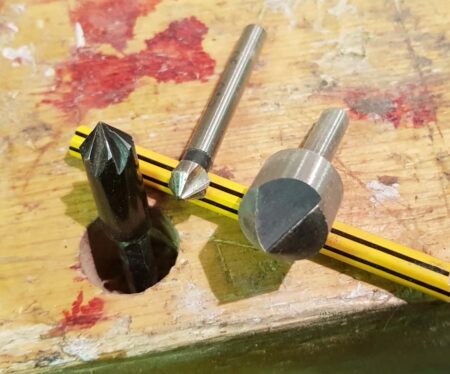
11. Countersink Bits
Countersink bits create a shallow recess in wood to accommodate screw heads. This permits the screw to be hidden under the surface of the wood, making it less visible from the outside. Countersinks tend to “chatter” with a power drill, creating a rough surface. Sharpening with a fine triangle file may help with this.
A Counter sink with clearance drill is a fantastic idea; they combine two functions in one. They cut a hole, countersinking it simultaneously, so the head has a nice, finished look.
This option is only cost-effective if you need many screws of the same kind for a job. Due to the design of the spur tips, sharpening these bits might be tricky. It can go fast through timber and plasterboard (even some plastics).
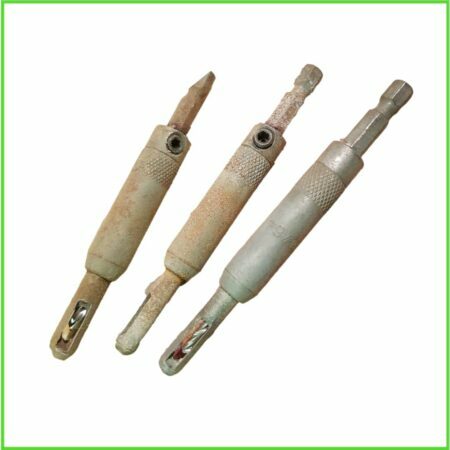
12. Hinge Drill Bit
The self centering hinge drill bit set with a hex shank is a must-have for any toolbox. A specialist tool, it centers itself and stops slipping off the hinge leaf for easier work.
13. Step Bit
Step drill bits are handy for wood and thin sheet metal projects. A stepped design allows them to create several diameter holes in a single pass.
They have a titanium-nitride coating to reduce heat build-up and keep them lubricated. This allows them to cut without getting too hot or becoming difficult to use.
14. Bullet Pilot Point
Bullet drill bits are for use on glass or porcelain but also uses on metals, wood, and plastics. They have a diamond ground carbide tip that allows for precision.
Producing straight and clean holes, they cause little damage when breaking through. It must run at a very slow speed with no hammer action to achieve this. Additionally, coolant is recommended when using these bits.
Bit sizes range from 1.5 to 13 mm, making it easy to find the right size for the job at hand. The most popular is 8 mm, but you want to have a variety of sizes to cover all your needs.
Materials and Finishes Used in Different Drill Bits
Drill bits for woodworking come in a variety of styles and finishes. Each has unique benefits and drawbacks; you need to consider for the right one. Some of the most common types of drill bits include:
Steel: They work well in softwood but need lots of sharpening in hardwood.
HSS (High Speed Steel): These are general-purpose bits for most materials. They balance hardness and toughness well and come in various sizes.
Cobalt: Cobalt bits are very hard and dissipate heat. Good for aluminium and tough metalwork such as stainless steel.
Tungsten carbide: Tungsten is a very hard material that can withstand high temperatures. However, it is also brittle and can shatter if not handled correctly. Harder materials like concrete and metal may be drilled using TC tipped masonry drill bits.
Titanium Nitride (TiN): A gold-colour coating added to increase performance and reduce friction. It makes them harder and more wear-resistant, helping dissipate heat faster.
Black oxide drill bits have a treatment that resists corrosion and lasts longer than basic bits. Uses in many materials, including metal, wood, softwood, PVC and fiberglass.
Bit finish is also important to consider to choose the right tool for the job. Each finish has advantages in cutting ease, noise, and long-term performance. A big misconception about drill bits is they are not interchangeable across materials.
Which Type of Drill Bits For Wood Holes Should I Choose?
There is no simple answer to this question. It depends on the type of wood you’re drilling and the size of hole you need. Before purchasing, consult with a drill bit guide or your local hardware store.
Choosing the best bit, you should also ensure it suits your purpose and particular wood.
- Consider the material.
- What is the application?
- Sharpness and speed of the bit.
- Shank size.
- Chuck diameter.
- Torque of your equipment.
- Hole depth. Of the available tooling, which is most suitable for the task.
Dull or improperly-sized bits can damage your workpiece and may even result in injury. Always wear eye protection, and hold the tool by its handle when in close quarters (less than 2 feet). You should tidy up your workspace before you begin drilling. Pieces of debris and dust can fly up and create dangerous projectiles.
When drilling into wood, it is vital to use the right drill bits and take care not to overheat them. Allow them to cool down before replacing or removing with a glove. You can also use a lubricant to help keep things cool.

